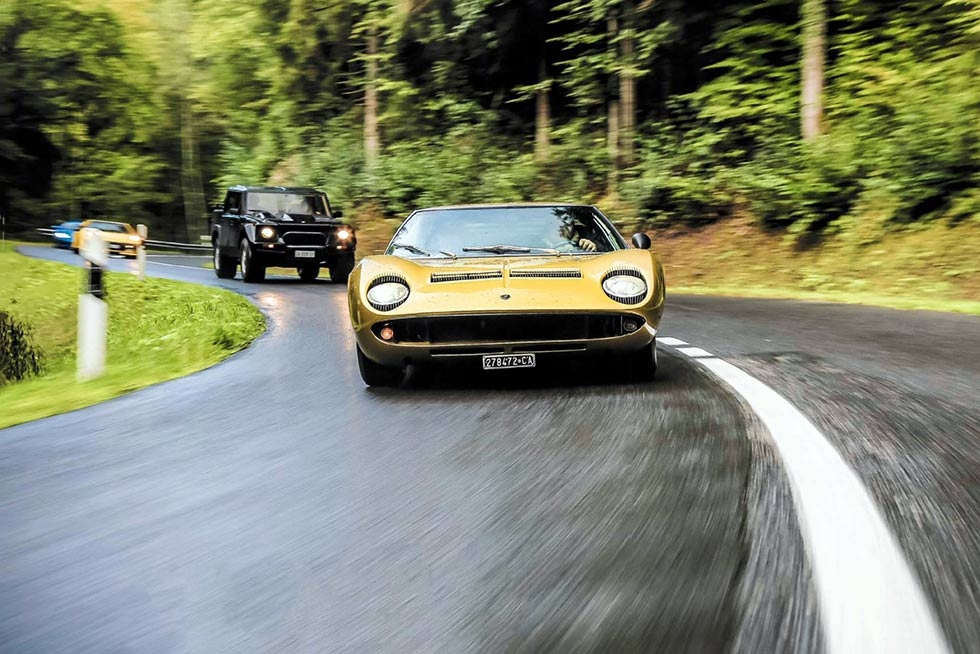
The Design Chasers Spectacular Alpine scenery and architecture, by Lamborghini Jalpa, Huracán, Miura and LM002. Lamborghini takes a bunch of enthusiastic owners on a design-themed tour of Switzerland. We grab the keys to a Miura, Jalpa, LM002 and Huracán to explore the extremes Words Phil Bell. Photography Phil Bell and Lamborghini.
Celebrating design radicalism in all its forms in Switzerland, by Lamborghini
The early morning sunlight has to strain through a thin veil of cloud before it reaches the cars outside my hotel, but I pluck Ray-Bans from jacket and slide them on to my nose anyway. Eyes and sensibilities need them to cope with the dazzling Giallo Fly Lamborghini Jalpa that will be mine for the next couple of hours. Along with dozens of real owners driving everything from early-Sixties 350GTs to the latest Huracáns, I’m looking forward to a day on the Lamborghini & Design tour. Among the wild assemblage of V12, V8 and V10-powered chargers I pick out the Miura P400S, LM002 and Huracán LP610-4 that I will drive later.
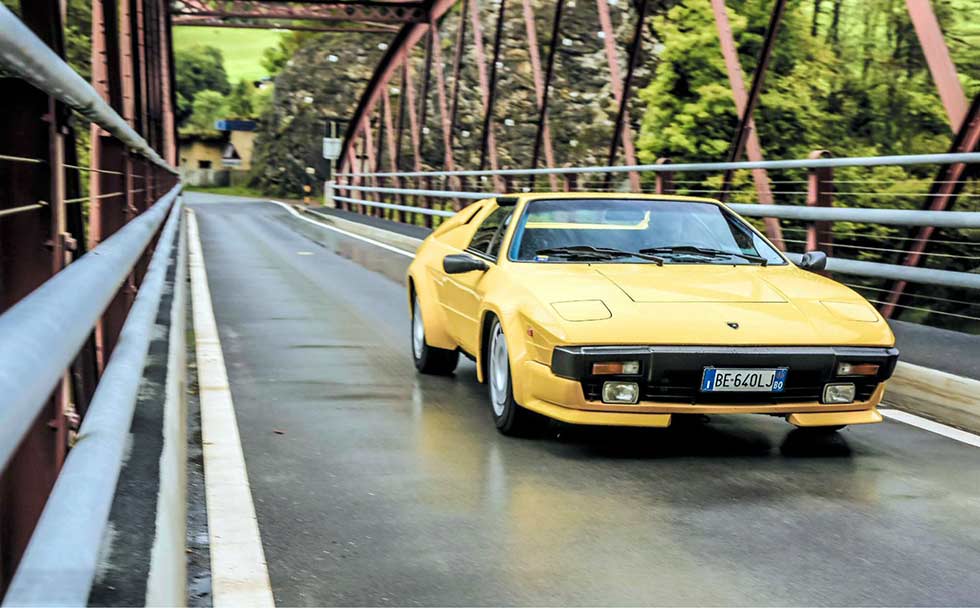
But for the moment I only have eyes for this setsquare-draughted wedge of Eighties extrovertism. It evolved from the Urraco – Lamborghini’s 1970 stab at the junior supercar market typiied by the Ferrari Dino and Porsche 911 – but via the Silhouette it had lost its plus-two seating and roof, gaining a lift-out targa panel and aggressive squared-of wheelarches. With money from the new Mimran ownership and the design whizz of Giulio Alieri the V8 became 3.5 litres, new lower-profile Pirelli P7s gripped larger 16-inch wheels and voilà, as they don’t say in Italy, the little bull Jalpa popped out at the 1981 Geneva show, blinking and ready to take on the Eighties. Today I’m blinking because I’ve popped open the door to find an interior clothed in bright blue leather. Piped red. Whoever specced up this last Jalpa in 1988 was going for the full Eighties experience.
Now it’s my turn, and I smile at the blocky, sci-fi light deck dashboard, complete with its slab of bold warning lights. None is marked ‘rocket booster’ or ‘laser guns’ so I twist the trad ignition key to hear that quad-cam V8 stir into a bustle of valvegear chatter. Dogleg the gearlever down and left into first, feel the weight of the clutch pedal and we’re of, nosing through the Neuchâtel traffic in what must be the most outrageous convoy ever to hit this part of Switzerland.
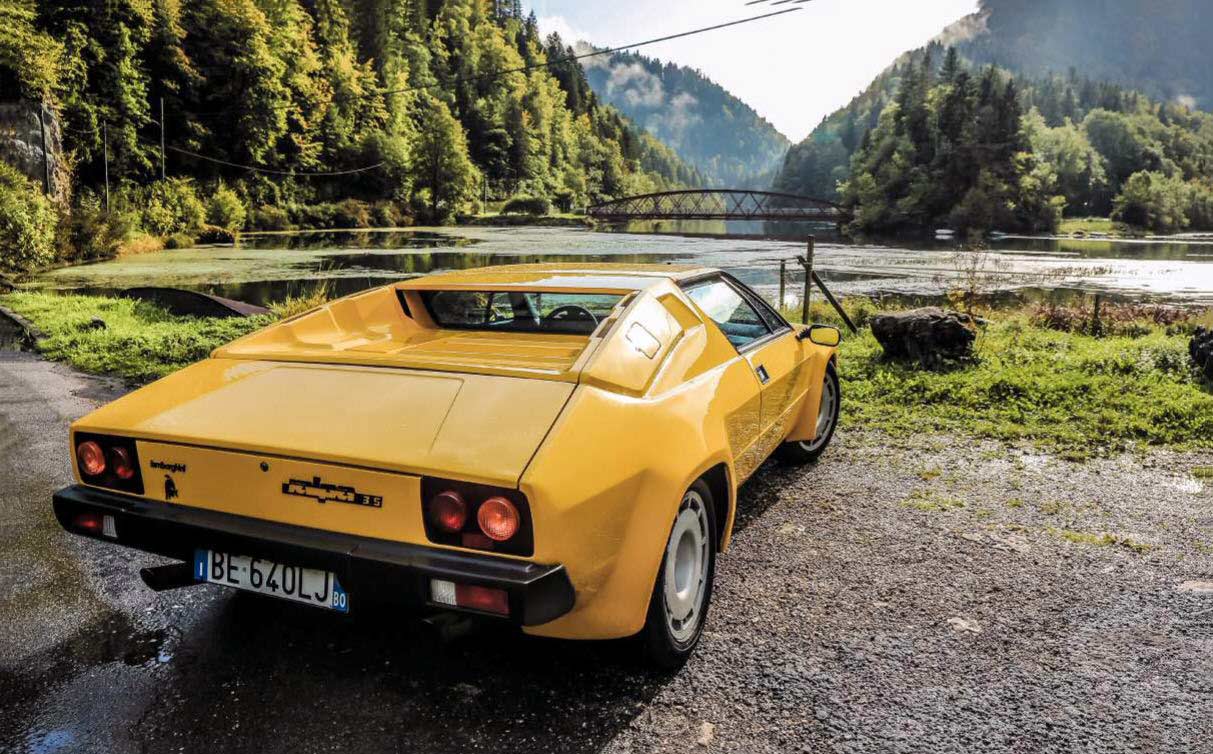
Escaping the shadows of grand facades we head south, the road hugging the north shore of a lake Neuchâtel bathed in silvery light. So far the Jalpa is proving a credible rival to its Porsche and Ferrari targets – a roomy, torquey, temperament-free travel companion. But isn’t a Lamborghini supposed to be a bit bonkers as well? Time to leave this lakeside cruising to the locals and head for the hills – the Jura range that separates us from the French border. That V8 is happy to pull from 2000rpm, but take the weight of the clutch, feed the gearlever through its long and deliberate action and dig hard against the stiffly sprung throttle and it loves to sing, revving out with an angry, crisp snarl. Ooh yes, that’ll do nicely. Vineyards now line the road as it sweeps back and forth in perfectly drawn arcs, and in the mirrors I see foreboding clouds smothering distant mountains. Hope they’re not heading this way.
After a whiff of straight-ahead steering deadness it’s a joy to feel it weight up into bends, changing course with precise luidity and quickly winning my confidence. Brakes too – the pedal having the lightly-servoed solidity that allows precise modulation without demanding excessive effort. It frees my mind to savour the wicked crack and popple of quad exhausts on every overrun opportunity.
The road bursts out on to a fertile plateau sprinkled with farm buildings and the enticement of clear-sighted corners before plunging into woodland and climbing once more. Cut rock to the left, dense forest steeply falling away to the right, comprehensivelooking barriers in case things get a bit too wild. Then it’s back to grassy farming plains and the occasional barn with its doors invitingly open. I’m just pondering whether I’d get away with slipping out of convoy and hiding the Jalpa in one of them when we have to pull over and swap cars. Pity, I’ve enjoyed its surprisingly 911-like blend of invigoration and user-friendliness. Wonder if the new Huracán will win my affections so easily.
Filippo Perini’s stealth-fighter-meets-angry-stinging-insect styling promises a savage experience, and the future-tech interior keeps tensions heightened – that START ENGINE button looks like something you’d use to arm a computer-guided weapon. It is. Lift the red protective toggle, prod the black button beneath and 5.2 litres of V10 packing 610bhp grumbles angrily to life. But it trickles away from standstill with a tease of the throttle, steering offering reassuring weight but demanding little effort.
At a lazy 1500rpm cruise this spacious spaceship offers limousine refinement, choosing your next gear ratio early under light throttle and demanding little commitment, other than that you take time to appreciate your environment. Pop it into SPORT, pluck one of the batwing-sized shift paddles down a couple of ratios and hear it throw in a snarly throttle blip before unleashing warp drive, a deliciously ierce lunge of howling energy that licks the speed limit to one side like a discarded cigarette butt.
And its smart electronics learn your habits, the electrohydraulic dual clutch taking feedback from sensors on the suspension wishbones, gyroscopes and accelerometers to control how much of the 413lb ft torque you’re allowed. And the double armoury of common rail direct fuel injection and indirect multiport ensures there’s rather a lot. Enough to swallow what looked like a nice long acceleration run in the pulse of a brain synapse. But the brakes offer a matching blend of brawn and brains to kill speed as gently or fiercely as I need, hauling this 1532kg sculpture of aluminium spaceframe and composites with giddying ease, allowing me to choose just how much I lean on it through the next complex of curves as they rise and fall down to La Chaux-de-Fonds, and the promise of lunch. As the town limit speed signs appear I half expect GAME OVER to pop up on the dashboard graphics, and I wonder how much of that thrilling drive was down to my skill, how much was masterminded by computer algorithms. As I pop the door I decide to park my chrome-era purism and bank the experience as jolly good fun. Time for lunch, and the chance to debate the relative joys and ownership challenges of modern versus classic supercars with a Miura-owning couple from England. Despite the huge capabilities and user-friendliness of their modern supercars, these two are clearly falling increasingly under the spell of their classic Lamborghini, foibles and all.
With a double shot of espresso we’re of to Villa Jeanneret- Perret, more commonly known as Maison Blanche. Hanging high on the hillside overlooking the town, this is the first house designed and built by Charles-Edouard Jeanneret when he was just 25, pretty much the same age as Gian Paulo Dallara, Paulo Stanzani and Marcello Gandini when they created the radically fresh Miura.
Though made for his parents, this was him kicking against the established art nouveau movement and before he adopted the name Le Corbusier. Radical buildings by this unqualiied genius are part of the tour’s Design theme. It’s hard to comprehend that this one was built in 1912, with its concrete pillar structure, ten different types of window and then-modern materials, from the linoleum flooring to the fibre cement roof tiles. When a guide tells us that he also designed the piano for his mother I wonder if the gene for her talent is linked to design creativity – Gandini trained as a pianist before turning his hand to cars.
In any case, from here it’s a short trip across town to Villa Schwob/Villa Turque, commissioned by watchmaker Anatole Schwob – this town is the epicentre of Switzerland’s watchmaking and now microtechnology industry – and finished in 1916 around a spectacular double-height living room with galleried landings feeding the bedrooms. The dream is made complete by a couple of garages set into the garden wall. I can’t find out if they’re a later refinement, but my thoughts soon turn to what I’d put in them.
Ah, Lamborghinis. I slip through the wall of cameraphone wielders and attempt a discreet exit. In a Huracán. Escaping La Chaux-de-Fonds, our tour soon finds a narrow ribbon of tarmac that picks its way down into a steep valley. My enthusiasm for digging even deeper into the car’s chassis poise and grip is metered by a fresh dousing of rain as increasingly tall trees crowd out the depleted afternoon light. So I settle into an easy rhythm – brake-downshift-blip, caress the steering, squirt of V10, repeat – until the river Doubs appears through the trees, along with my turn to part with the Huracán. The ease with which it helps the driver conquer rapid travel seems a guilty pleasure.
Glowing in fresh sunlight from a clearing sky is a car that will make me work much harder for my rewards, a Miura P400S, raindrops glittering on its Oro Metallizzato paintwork. The earlier 350GT and derivatives may have fulilled Ferruccio Lamborghini’s ambition to build a more civilised Ferrari alternative, but the wild-child Miura of 1966 would define the company for all time. Inspired by the Ford GT40 road car, its execution drew on everything from the Mini’s transverse-mounted engine atop gearbox to a helicopter fuselage for its welded sheet steel platform riddled with holes for lightness.
Without convincing evidence for LJK Setright’s 1986 assertion that the quad-cam V12 engine was designed by Honda, I’ll follow conventional wisdom and credit Giotto Bizzarrini for the initial 385bhp at 9800rpm quad-cam incarnation and Dallara for civilising it into a road car engine.
In this soft afternoon light, in this colour, Gandini’s vision of fluid curves and delicate edges looks conventionally sensuous, even with its garnish of black strakes and vents. Back then it looked as radical as the engineering beneath, especially in the acid-kaleidoscope choice of colours available. The view from the driver’s seat is just as dramatic, with big speedo and tacho gauges jutting straight out from the dashboard like an oversized pair of binoculars, and a bank of minor gauges leering at me from the right. It’s been a while, but I’d forgotten just how kart-like these cars feel. Knees splayed alongside the absurdly reclined steering wheel, shoulders hunched from the reclined bucket seat to reach it – this was ergonomics before anyone could spell osteopath.
Churn the already-warm V12 and a quartet of triple-choke Webers gives up just enough fuel to help it cough into life, quickly settling into an urgent, chuntering throb laced with busy chain thresh. As I give the lever a hard push into first I’m mindful of the linkage reaching all the way back through the sump to the gearbox. The rainclouds are gone, leaving isolated swatches of mist clinging to the dark pines, and tarmac that still glistens wet on the road home. I leave the river behind and let the 4.0-litre remind me how 370bhp moves 1320kg. The detonations of 12 cylinders meld into a searing, hard-edged blur when the tacho needle sweeps past 5000rpm. Compared to the original Miura, the P400S brought an extra 20bhp and altered rear wishbone mounting points to reduce squat under acceleration. And thrust is still exhilarating as much for the drama as the physics – it’s more than two seconds slower to 60mph than a Ferrari Daytona, but on this twisted climb give me the agile Miura any day. I feel like I’m sitting on it in arse-on- the-road kart style, looking down over its low lanks to size up the road, and enjoying the way the whole car seems to pivot about said backside. Its 173mph top speed would take much longer stretches of road than this to test, but prior experience says the nose starts to feel disconcertingly light long before it gets there. Back at the Miura’s launch it was all about ultimates, but these days cars like the Huracán need barely tickle their abilities to surpass them. But the old car is no less thrilling, because getting the best out of the P400S on roads like these demands all of your skills, all of your focus and a fair chunk of bravery.
We break free of the tree line and spear back across farming plains, but none of the barns looks secluded enough for me to stash the Miura either. I’m going to have to give it back, and our convoy pulling over tells me that that time has come already. I extricate myself, feeling a pang of I-don’t-want-the-party-to-end sorrow until my next Lamborghini scrunches to a stop. Despite its big, brutal presence, the cartoonish LM002 makes me smile. A quad-cam V12-powered of-roader born out of a failed bid, called Cheetah, to supply the US military with a High Utility Mobile Vehicle (note the acronym). At the Mimrans’ behest, it was repurposed in 1986 into a luxuriously appointed king of the Arabian sand dunes to cut the project’s losses.
So I step up into a world of soft caramel leather and polished woodwork with a smirk of scepticism. Its simple binnacle, stocked with gauges, has more than a hint of Ford Capri about it, but not even the Ghia had so many push switches, let alone ones with legends A/C or WINCH. No Seventies Capri redlined at 6450rpm either. So will its rabid 5.2 litre V12 try to fight its way out of this caricature Judge Dredd truck? Well at idle it sounds subdued, contented even, so I pull away wondering if 2600kg will blunt its spirit. Not if I rev it out to 6000rpm in every gear – it’s surprisingly keen to get up and go if given a workout, and revving out a Lamborghini V12 doesn’t count as a hardship. As the tour gathers pace my view down that slab of a bonnet recalls a cross between Mad Max and Convoy and more than once I find my right hand flailing in space as it reaches high across the transmission tunnel in search of gearlever. Once found, the shift is firm, positive – like all of the controls. Reminders of the bulk that needs taming, none more so than when I have to haul of speed for a downhill hairpin and all of that mass seems to strain forwards. Settle bespoke Pirelli Scorpion tyres (£2000+ apiece!) into corner, shoulder the weight and it powers through with little roll. This contradiction on wheels has confounded my expectations and as our route straightens out for its home run alongside lake Neuchâtel, I realise that my scepticism has turned to respect, admiration even.
At journey’s end it even copes with the confines of the hotel’s underground car park, where I must abandon it amid row upon row of Lamborghini brethren, hundreds of power-giving cylinders and dozens of raucous tailpipes silent in the gloom. Time to pick up the modern Lambo/old Lambo debate over a beer with my fellow travellers. We’ve got even more to talk about.
Thanks to Clara Magnanini at Lamborghini
TECHNICAL DATA FILE SPECIFICATIONS 1988 Lamborghini Jalpa 350
Engine 3485cc V8, dohc, four Weber 42 DCNF carburettors
Power and torque 255bhp @ 7000rpm; 231lb ft @ 3250rpm / DIN
Transmission Five-speed manual, rear-wheel drive
Suspension Front: independent, MacPherson struts, lower wishbones, anti-roll bar. Rear: independent, Chapman struts, lower wishbones, trailing links, anti-roll bar
Steering Rack and pinion
Brakes Vented discs front and rear, servo-assisted
Weight 1499kg
Performance Top speed: 145mph; 0-60mph: 6.1sec
Fuel consumption 16.5mpg
Cost new £26,423 at 1981 launch
Classic Cars Price Guide £17,500-£70,000

‘This must surely be the most outrageous convoy ever to hit Switzerland’
TECHNICAL DATA FILE SPECIFICATIONS Lamborghini Huracán LP610-4
Engine 5204cc V10, dohc/bank, 40 valves, variable timing, Bosch MED direct and multipoint injection
Power and torque 610bhp @ 8250rpm; 413lb ft @ 6500rpm / DIN
Transmission Seven-speed LDF dual clutch, Haldex Gen V electronically controlled four-wheel drive
Suspension Front and rear: independent, wishbones, coilover self-adjusting damper units, anti-roll bars, anti-squat bars
Steering Electromechanically assisted Servotronic
Brakes Carbon-ceramic vented discs with ABS, ASR and ABD
Weight 1532kg
Performance Top speed: 201mph; 0-62mph: 3.2sec
Fuel consumption 19.5mpg
Cost new £180,720 (base price at 2014 launch)
Classic Cars Price Guide £135,000-£185,000
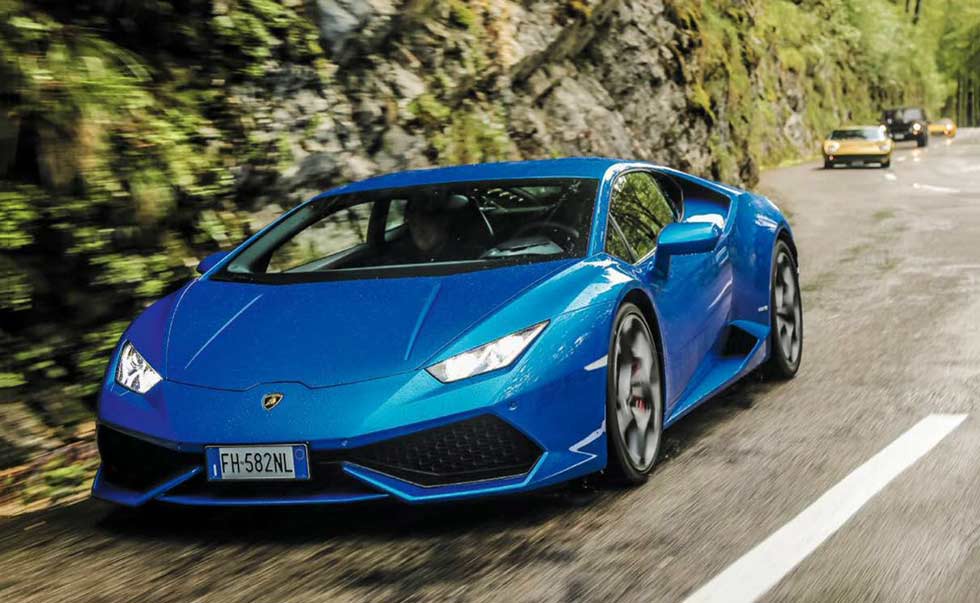
TECHNICAL DATA FILE SPECIFICATIONS 1970 Lamborghini Miura P400S
Engine 3929cc V12, dohc, four Weber IDA 3C carburetors
Power and torque 370bhp @ 7700rpm; 286lb ft @ 5500rpm / DIN
Transmission Five-speed manual, rear-wheel drive
Suspension Front and rear: independent, unequal-length wishbones, coil springs, telescopic dampers, anti-roll bars
Steering Rack and pinion
Brakes Discs front and rear, servo-assisted
Weight 1320kg
Performance Top speed: 172mph; 0-60mph: 6.7sec
Fuel consumption 13.4mpg
Cost new £10,860 (1970)
Classic Cars Price Guide £550,000-£1.2m
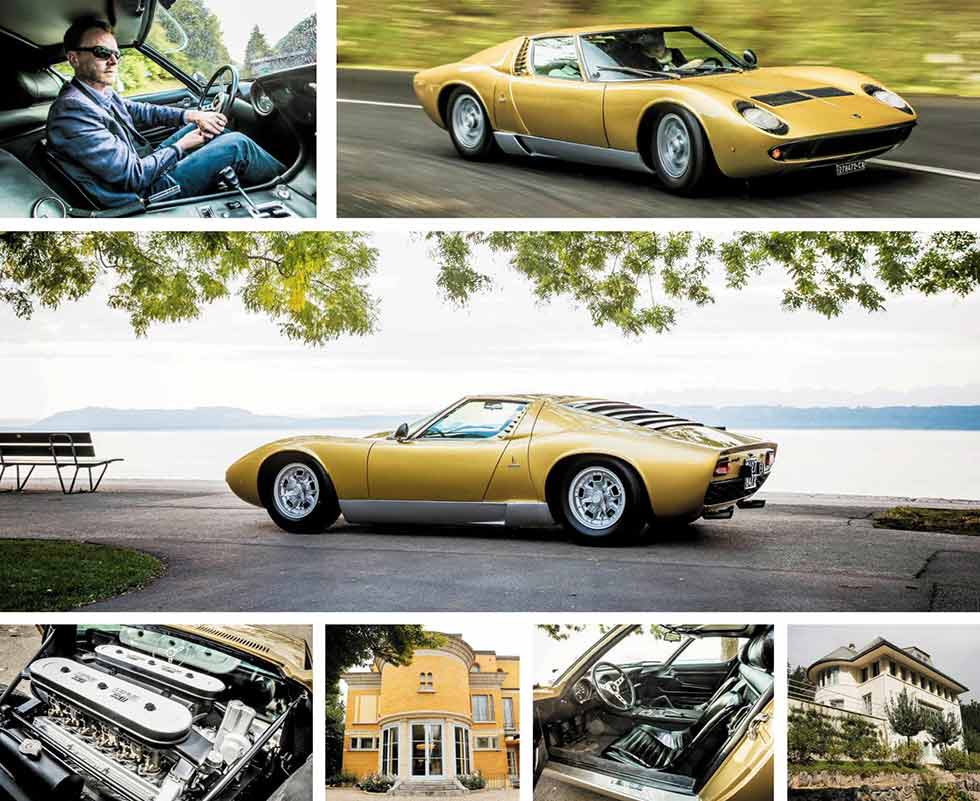
‘The detonations of 12 cylinders meld into one hard-edged blur’
TECHNICAL DATA FILE SPECIFICATIONS 1991 Lamborghini LM002
Engine 5167cc V12, dohc, 48-valve, Lamborghini LIE fuel injection
Power and torque 414bhp @ 6800rpm; 368lb ft @ 5000rpm
Transmission Five-speed manual, three differentials, four-wheel drive
Suspension Independent front and rear: wishbones, coil springs, telescopic dampers, anti-roll bars
Steering Power-assisted recirculating ball
Brakes Front: ventilated discs with two four-piston calipers per disc; rear: drums, servo-assisted Weight 3109kg
Performance Top speed: 121mph; 0-60mph: 7.7sec
Fuel consumption 8mpg (30l/100km)
Cost new £60,000 at 1986 launch
Classic Cars Price Guide £140,000-£330,000






